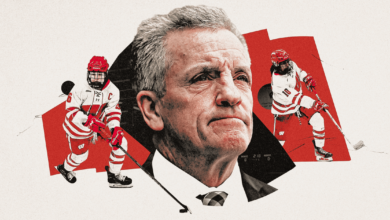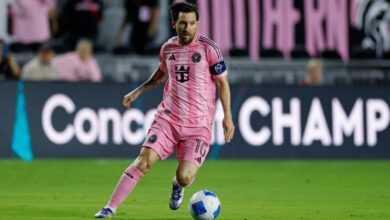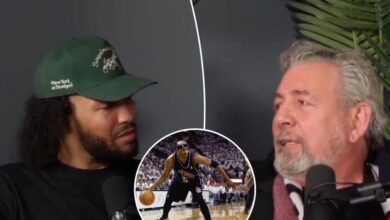Inside Warriors center James Wiseman’s 18-month rehab

AS HE WALKS to the team bus from the Saitama Super Arena outside of Tokyo, James Wiseman can’t wipe the grin off his face.
It’s Sept. 30, and the Golden State Warriors have just beaten the Washington Wizards, their first game during their five-day voyage in Japan. Images of Andrew Wiggins and Jordan Poole holding hedgehogs had gone viral. Stephen Curry and Klay Thompson had taken on a sumo wrestler in practice the day before.
But perhaps the biggest story of their preseason trip was the quiet return of the Warriors’ 21-year-old 7-foot-3 center, a man already more maligned for what and who he isn’t than what he still could be.
Back in the arena, as Wiseman gets closer and closer to the bus, he can’t stop talking about what he had just accomplished: He had played in his first NBA game in a year and a half. He scored 20 points — 10 of them on dunks, one of which was over Kristaps Porzingis.
“I finally caught a body,” he says, his smile widening.
It was 18 months in the making.
After a meniscus tear in April 2021 and a tumultuous rehab, Wiseman was finally back on the court and in an NBA game. And ever since his injury, Wiseman had been preparing for that moment.
Following the subsequent operation to repair his knee, Wiseman’s activities were limited solely to upper body work. He spent the summer in the weight room and lifted, gaining seven to 10 pounds of muscle.
Once he was cleared to work on his lower body, Wiseman started with simple knee extensions, working on regaining the mobility he had once taken for granted.
All of his basketball training was relegated to the video room. Wiseman would sit for hours with assistant and player development coach Dejan Milojevic and dissect everything they saw. They watched film from Wiseman’s games. They watched teammate Kevon Looney. They watched other centers around the league — both current and former. During the Finals, Wiseman studied Boston Celtics center Robert Williams III.
Following NBA summer league in Las Vegas — where Wiseman played five games, his first showing since a trio of G League games in March — not a weekday has gone by in which Wiseman wasn’t in the Warriors’ training facilities.
“Finally things began to click for James this summer,” Warriors coach Steve Kerr says. “He played more pickup ball this summer than anybody on our entire roster, and he’s getting rep after rep. His knee is feeling great and everything is finally happening, but only because the reps are there for him. Everything that we’ve been showing him, he can now feel.”
In Vegas, the Warriors held hourlong scrimmages, and Wiseman was the only roster member who participated in all of them. These scrimmages offered something Wiseman hadn’t experienced in a year and a half: playing time.
“I don’t got any personal expectations this year,” Wiseman says. “I really just want to win and get better. I’m still coming back from an injury, so it’s going to take a while. It’s about gaining momentum, but I am ready.”
IT WAS THE second quarter of the Warriors’ April 10 game against the Houston Rockets. Wiseman caught a pocket pass from Poole and immediately drove to the hoop for a dunk.
Wiseman felt something pop in his knee as he landed awkwardly.
At first, he didn’t think much of it. He thought it was a bone bruise.
“When [trainer] Rick [Celebrini] told me it was worse, I just broke down in tears,” Wiseman says.
As the reality of what that meant for his first year in the league continued to wash over him, Wiseman sat in the Warriors’ parking garage at Chase Center crying for hours.
His mother had to come to console him and help him get home. After what Wiseman called “simple momma love,” he finally left the arena.
The external discourse began almost immediately — that he was a flop, that the Warriors should have drafted LaMelo Ball with the No. 2 overall pick instead, that Wiseman’s inability to stay healthy warranted him being traded.
Kerr could see it affecting the then-19-year-old’s mood. So in the spring, a few weeks after the injury, Kerr approached Wiseman with a proposition: both of them give up Twitter for six weeks.
“If you spend too much time on social media, you will feel yucky,” Kerr says. “There is a lot of judgment and criticism, and we are all human. We’re all vulnerable to that but especially [a] guy without much life experience, basketball experience.”
Wiseman agreed, and started journaling and began going to therapy. He started to write music, too. He found that if he could figure out how to verbalize his feelings and emotions, it was easier for him to cope with stress.
When Wiseman was in college, he took writing classes and often wrote poetry. But it wasn’t until his injury that he started writing and recording rap music.
“The lyrics, I am really just speaking from my heart,” Wiseman says.
Therapy was new for Wiseman, but it’s something he says he needed and has continued now that he’s back on the floor.
“As a man, we are taught to hold everything in, especially as a Black man,” Wiseman says. “I just couldn’t hold everything in because it was going to destroy me. I had to let it out. And honestly, that makes you strong — to be able to be vulnerable and actually express it to someone you don’t know.”
He turned to Thompson, who was doing his own rehab after consecutive ACL and Achilles injuries.
When the team was on the road and Wiseman and Thompson were stuck at home rehabbing, they would take rides on Thompson’s boat in the San Francisco Bay. When they became healthy enough, they’d spend their time playing one-on-one.
“I got to see his work ethic every single day,” Thompson says. “To be that young and to go through that, you have to be really mentally strong. … You know you’re capable of [great] performances, so it kills you inside.”
Thompson told Wiseman upon his return that he’ll have to adjust how he measures his own success — something Thompson was learning in real time. And Thompson continues to remind the young center that for all the patience it has taken to get back on the court, it’ll require even more to return to pre-injury form.
“It’s different for him because we have such an established team right now, but we will not be here forever and one day, this will be his team,” Thompson says. “The responsibility gets greater, so I tell him to just enjoy his time now.”
IN MARCH, WHEN it looked like Wiseman would return well before the postseason, Kerr told ESPN it was unfair for spectators to put such lofty expectations on Wiseman. He said that when Wiseman came back, his role would be small as he worked his way into shape.
But this season, Kerr is offering no such qualifier. “He’s a diving 5, rim threat, lob threat,” Kerr says. “Vertical spacing is great. He adds a different dimension to our team — and he is going to get minutes.”
Following Wiseman’s first preseason game in Japan, Kerr said Wiseman’s feel for the NBA game was miles ahead of where it was when he was drafted.
His comfort level shows in knowing where he needs to be on the court, understanding spacing and not overcomplicating his game. That’s the key for Wiseman to have a successful season, Kerr and Milojevic say.
But they also know he will make mistakes. Wiseman knows that, too.
“The lesson is patience,” Kerr says. “And patience has to come in the midst of a profession where there’s very little allowed by fans and media. You have to ignore the noise and help the player through the noise. What a novel concept — the combination of patience and work ethic.”
Just as Kerr and Thompson have reiterated over the past year and a half, Wiseman will need to tap into his patience as he plays his first regular-season games since his injury.
Wiseman’s return is 18 months in the making. He’s no stranger to patience.
“I know what I am capable of on the basketball court, but people need to give me time to grow,” Wiseman says. “They put so much pressure on me to be this, to do that. … I need to be myself and not care what people say.”
Source link




